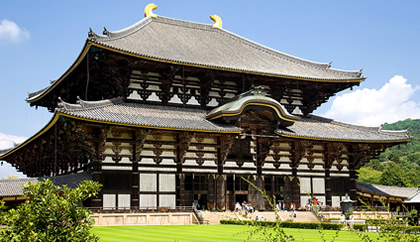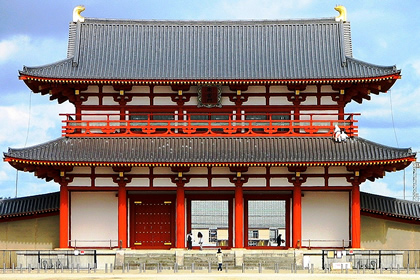World History
Nara is a city and prefecture in central, inland Japan that acted as the capital between 710 and 784. Prior to the Nara period, the capital of Japan was moved from city to city at the behest of an incoming emperor.
However the accession of Shomu, who had been brought up in the expectation of and preparation for rule, changed this custom and set about developing the cultural and administrative basis of the state. His city, Nara Heijokyo, was modeled on the great Chinese city of Chang’an and it was decorated with imposing Buddhist temples.
In particular, the Todai temple was established as the central temple of the state in 752 and it was adorned at considerable expense with its Daibatsu or giant statue of Gautama Buddha. Two years later the Chinese monk Ganjin visited Nara, after years of travail, and he helped to establish Buddhism in the state and to create the great temple of Toshodaji.
Several schools of Buddhist thought flourished, but Naran emperors particularly favored the Sutra of Golden Light, which focused on the Lord Buddha as the essence of universal law in addition to his human nature.
Most Japanese in this period were involved in agricultural activities and pursued forms of Shinto beliefs, which center on the worship of or respect for animist nature spirits known as kami. Buddhism and Shinto were able to exist together in syncretic form.
Buddhist thought was spread throughout the state by means of building a kokobunji regional central temple in every province, which would be the home of monks and nuns, spread learning, and act as repository for the people’s devotion and donations.
In later years, some of these kokobunji and their controllers obtained considerable wealth and influence and acted to counter imperial power. They contended at the imperial court for favor with other important figures, including the Fujiwara clan, who had acted as imperial court-appointed regents since the time of Emperor Tenchi (r. 661–671).
Additional administrative improvements included the creation of infrastructure, especially roads, and the decentralization of power, which enabled the growth of shoen, which were landholding estates able to yield taxes in a much more efficient manner than had previously been possible.
Writing in the Japanese language was further developed and this assisted efficiency of rule. Society under Naran emperors exhibited a degree of social mobility that was almost unprecedented, and the many changes in the governance of society and in personal and state philosophies represented opportunities for enterprising individuals.
The court of Nara maintained very cordial relations with the Tang (T’ang) dynasty emperors, although this was interrupted by the An Lushan (An Lu-Shan) Rebellion, which hindered communications and the power of the Tang emperors.
However relations with Silla on the Korean Peninsula deteriorated, partly as a result of the ascendancy of Paekche in the north of the peninsula. Sovereignty was claimed, but no attempt to enforce it was realistically possible.
The Nara period ended in 784 when the new emperor Kemmu, less welcoming of Buddhism, transferred the capital to Nagaoka and then 10 years later in 794 to Heian, after which the subsequent Heian period (794–1185) is named. Nara is now a designated World Heritage Site and the Nara period is regarded as something of a golden age.
- Fujiwara Clan
Fujiwara clan symbolThe Fujiwara clan rose to power as a result of the coup d’etat of 645 that overthrew the Soga, which had dominated the Japanese government until then. The period between c. 857 and 1160 is called the Fujiwara period. Even after...
- Heian
Heian building The term Heian is derived from modern-day Kyoto’s previous name of Heian-kyo, a city founded in 794. The literal translation of Heian-kyo is “Capital of Peace and Tranquility†and was meant to reflect its peaceful and...
- Taiho Code
map of provincesThe Taiho Code went into effect in 702. It symbolized the advances Japan had made since the sixth century in the establishing of a state in the Chinese style. Prince Shotoku Taishi had begun the practice of sending Japanese students to...
- Tenchi (tenji)
Tenchi (Tenji)The man who later became Emperor Tenchi played a major role in the coup d’etat that ousted the Soga clan from power in Japan in 645. His reign was remarkable for the many steps taken to advance Japan by implementing reforms modeled...
- History Of Japan
History of Japan. This is a brief history of the Asian nation of Japan. It gives very little attention to most of Japanese history and instead focuses on the last 250 years. I have been in Japan twice but it was only to change planes. I hope to really...
World History
Nara
 |
| Nara - Todai temple |
Nara is a city and prefecture in central, inland Japan that acted as the capital between 710 and 784. Prior to the Nara period, the capital of Japan was moved from city to city at the behest of an incoming emperor.
However the accession of Shomu, who had been brought up in the expectation of and preparation for rule, changed this custom and set about developing the cultural and administrative basis of the state. His city, Nara Heijokyo, was modeled on the great Chinese city of Chang’an and it was decorated with imposing Buddhist temples.
In particular, the Todai temple was established as the central temple of the state in 752 and it was adorned at considerable expense with its Daibatsu or giant statue of Gautama Buddha. Two years later the Chinese monk Ganjin visited Nara, after years of travail, and he helped to establish Buddhism in the state and to create the great temple of Toshodaji.
  |   |
Several schools of Buddhist thought flourished, but Naran emperors particularly favored the Sutra of Golden Light, which focused on the Lord Buddha as the essence of universal law in addition to his human nature.
Most Japanese in this period were involved in agricultural activities and pursued forms of Shinto beliefs, which center on the worship of or respect for animist nature spirits known as kami. Buddhism and Shinto were able to exist together in syncretic form.
Buddhist thought was spread throughout the state by means of building a kokobunji regional central temple in every province, which would be the home of monks and nuns, spread learning, and act as repository for the people’s devotion and donations.
 |
| Nara main gate |
In later years, some of these kokobunji and their controllers obtained considerable wealth and influence and acted to counter imperial power. They contended at the imperial court for favor with other important figures, including the Fujiwara clan, who had acted as imperial court-appointed regents since the time of Emperor Tenchi (r. 661–671).
Additional administrative improvements included the creation of infrastructure, especially roads, and the decentralization of power, which enabled the growth of shoen, which were landholding estates able to yield taxes in a much more efficient manner than had previously been possible.
Writing in the Japanese language was further developed and this assisted efficiency of rule. Society under Naran emperors exhibited a degree of social mobility that was almost unprecedented, and the many changes in the governance of society and in personal and state philosophies represented opportunities for enterprising individuals.
The court of Nara maintained very cordial relations with the Tang (T’ang) dynasty emperors, although this was interrupted by the An Lushan (An Lu-Shan) Rebellion, which hindered communications and the power of the Tang emperors.
However relations with Silla on the Korean Peninsula deteriorated, partly as a result of the ascendancy of Paekche in the north of the peninsula. Sovereignty was claimed, but no attempt to enforce it was realistically possible.
The Nara period ended in 784 when the new emperor Kemmu, less welcoming of Buddhism, transferred the capital to Nagaoka and then 10 years later in 794 to Heian, after which the subsequent Heian period (794–1185) is named. Nara is now a designated World Heritage Site and the Nara period is regarded as something of a golden age.
- Fujiwara Clan
Fujiwara clan symbolThe Fujiwara clan rose to power as a result of the coup d’etat of 645 that overthrew the Soga, which had dominated the Japanese government until then. The period between c. 857 and 1160 is called the Fujiwara period. Even after...
- Heian
Heian building The term Heian is derived from modern-day Kyoto’s previous name of Heian-kyo, a city founded in 794. The literal translation of Heian-kyo is “Capital of Peace and Tranquility†and was meant to reflect its peaceful and...
- Taiho Code
map of provincesThe Taiho Code went into effect in 702. It symbolized the advances Japan had made since the sixth century in the establishing of a state in the Chinese style. Prince Shotoku Taishi had begun the practice of sending Japanese students to...
- Tenchi (tenji)
Tenchi (Tenji)The man who later became Emperor Tenchi played a major role in the coup d’etat that ousted the Soga clan from power in Japan in 645. His reign was remarkable for the many steps taken to advance Japan by implementing reforms modeled...
- History Of Japan
History of Japan. This is a brief history of the Asian nation of Japan. It gives very little attention to most of Japanese history and instead focuses on the last 250 years. I have been in Japan twice but it was only to change planes. I hope to really...
